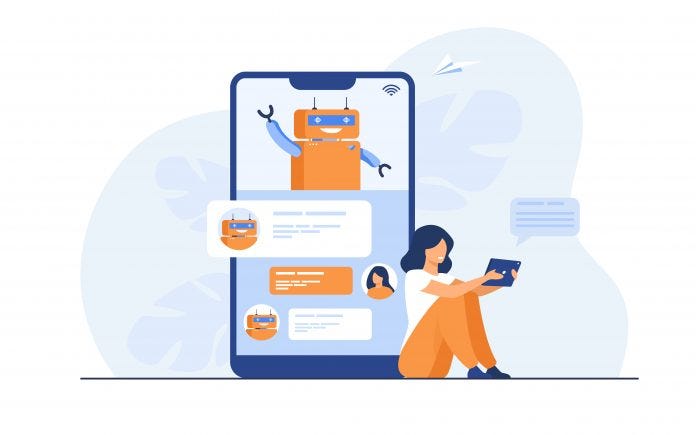
In an era of post-pandemic changes, organizations face challenges in creating exceptional service experiences for their customers. The pandemic has pressed the greater urge among industries for the creation of human-tech symbiosis to make the personalized customer experience as flexible as possible. So, what’s the next frontier in evolving employee-customer relationships?
The Answer lies in Conversational AI.
You might think voice interfaces are nothing new, but with the technology evolution, these voice interfaces have become better listeners and conversationalists. According to PwC, “ “around 27% of customers were unable to comprehend whether they interacted with a bot or human agents. And Conversational AI chatbot has made this possible.
Conversational AI uses technologies like Machine Learning and NLP to make human-machine communication possible. These AI technologies recognize the pattern in text and speech and translate their meaning across human and computer languages.
As per a report, “Around 57% of customers agree that Conversational AI bots can deliver a large return on investment for minimal effort.
On top of that Conversational AI constantly learns from previous experiences using machine learning datasets to offer real-time insight and excellent customer service. Also, Conversational AI not only manually understands and responds to our queries but also can be connected to other AI technologies such as search and vision to fast-track the process.
Technologies Inclusion In Conversational AI
1. Natural Language Processing
Although machines are quick and efficient, they are not experts in understanding human context, speech, or intent. But, Natural Language Processing with its capabilities such as text modeling, text categorization, text clustering, information extraction, and entity recognition understands the intent behind the text and speech and extracts meaning from the natural sentence to offer a personalized experience to customers.
2. Intent Detection
In general, intent defines what action should be triggered based on conversational inputs. And it becomes more typical when you have to find intent from voice instead of text due to our natural proclivity for telling stories. Using a combination of machine learning & NLP capabilities, the Conversational AI bot automatically associates words or expressions with a particular intent. And to make it one step further, intent detection can be combined with data extraction to identify specific datasets such as locations, dates, companies, names and etc.
3. Speech-to-Text
Once an information input is received from a human, machines can’t translate speech into text. To make the sense of what is spoken and asked, enterprises can leverage OCR technology integrated with a Conversational AI bot. By converting speech-to-text, Conversational AI bot enable enterprises to deliver better response for every interaction.
4. Value Extraction
Every company is data, but if your enterprises can’t make out what’s relevant, it’s challenging to scale. Value extraction is the model through which AI agents extract the relevant information from customer queries and store them against the relevant chatbot. Conversational AI reduces the manual effort by automating the slot labeling techniques and identifying the key specification from the user’s spoken instructions to a voice assistant autonomously. For example- a banking assistant has to extract the cash value and recipient in order to make a transaction on the user’s behalf.
5. Text-to-Speech
Manually processed conversion of text into speech require constant manual effort and cost to Text-to-speech process in Conversational AI involves the translation of the text into speech automatically. By using a pre-defined workflow with text records and identification Conversational AI bot can offer a faster response to natural text and speech.
How Conversational AI can be used for customer service?
Needless to say, Conversational AI is the best asset to offer a personalized and real-time customer experience. From resolving queries on time to understating user intent autonomously, Conversational AI has a lot to offer on its plate to customers. Conversation AI use cases for customer service include:
You might have heard of the statement that “Data is the new oil”. And enterprises have a huge amount of data collected from customer transaction history, past interactions, transcripted calls, and chat sessions. This invaluable information can be leveraged to create a hyper-personalized customer experience and quick service ticket resolution. Conversational AI monitors all the conversations that happened with customers and makes data of their requirements, and creates a powerful ecosystem for predicting customers’ next actions.
Regardless of industries, support agents need a vast amount of information to process resolution and answer FAQs. Conversational AI could be a great help in assisting the agents. By monitoring the conversations agents are having with customers, Conversational AI can extract the information and customer intent and transfer the required information to support agents at the appropriate time. This saves both customer and support agents time. That’s how Conversational AI offers superior customer experience, lowered support costs, and high employee satisfaction.
Conversational AI bots can be easily integrated with reservation and booking systems to fully automate the reservation process. This automated reduce the manual effort required in processing booking and reservation and sending confirmation to the customer. Also, this Conversational AI chatbot can offer a personalized experience to customers by learning from the customer’s past interactions.
Conclusion
No matter the type of organization you rule, small or big, customer service plays a key role in scaling the business and getting higher ROI. And Conversational AI is a helping hand not only to optimize the customer service game but also to rule in the competitive market. The Conversational AI moment is now, and it’s high time to paddle for better customer service with AI capabilities.
Author Bio

Vatsal Ghiya is a serial entrepreneur with more than 20 years of experience in healthcare AI software and services. He is the CEO and co-founder of Linkedin: https://www.linkedin.com/in/vatsal-ghiya-4191855/ Shaip, which enables the on-demand scaling of our platform, processes, and people for companies with the most demanding machine learning and artificial intelligence initiatives.
Originally published at https://technewsgather.com on May 30, 2022.
Re-imagining Customer Service with Conversational AI was originally published in Chatbots Life on Medium, where people are continuing the conversation by highlighting and responding to this story.